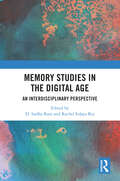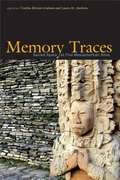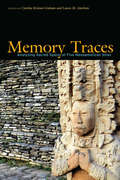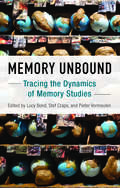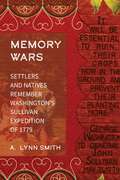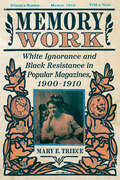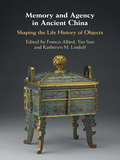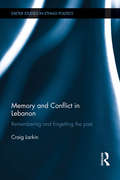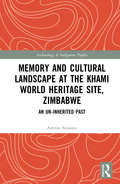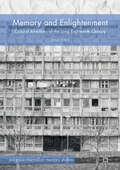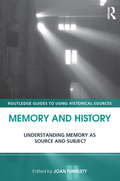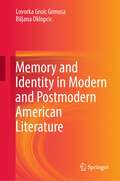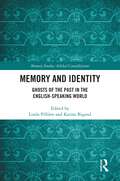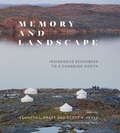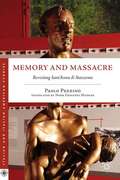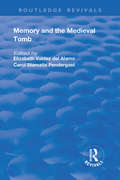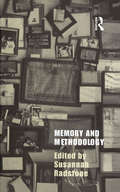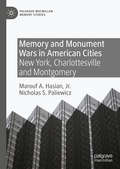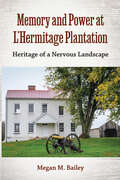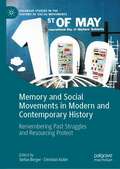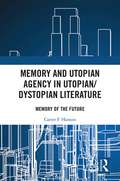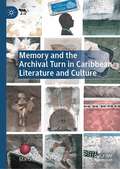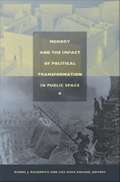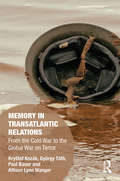- Table View
- List View
Memory Studies in the Digital Age: An Interdisciplinary Perspective
by D. Sudha Rani and Rachel Irdaya RajThis interdisciplinary volume attempts to gauge the individual and social issues related to memory, with an understanding of memory studies as an independent body of scholarship. It draws on multiple fields of knowledge, like popular culture, history, literature, oral cultures, and storytelling, which facilitates a panoramic view of memory studies.This book investigates the intersection between memory studies, partition, oral literature, and digital technology. It is also informed by the consciousness of memory in the digital age, which plays an integral role in what is remembered/forgotten, the form in which such memories are stored, and how they might be retrieved in future.This book will be an invaluable resource for those involved in research from undergraduate to post-doctoral level. This includes sociologists, psychologists, historians, artists, academicians, as well as research scholars from other disciplines.
Memory Traces
by Laura M. Amrhein Cynthia Kristan-Graham"In Memory Traces, art historians and archaeologists come together to examine the nature of sacred space in Mesoamerica. Through five well-known and important centers of political power and artistic invention in Mesoamerica--Tetitla at Teotihuacan, Tula Grande, the Mound of the Building Columns at El Tajín, the House of the Phalli at Chichén Itzá, and Tonina--contributors explore the process of recognizing and defining sacred space, how sacred spaces were viewed and used both physically and symbolically, and what theoretical approaches are most useful for art historians and archaeologists seeking to understand these places.Memory Traces acknowledges that the creation, use, abandonment, and reuse of sacred space has a strongly recursive relation to collective memory and meanings linked to the places in question, and reconciles issues of continuity and discontinuity of memory in ancient Mesoamerican sacred spaces. It will be of interest to students and scholars of Mesoamerican studies and material culture, art historians, architectural historians, and cultural anthropologists."
Memory Traces: Analyzing Sacred Space at Five Mesoamerican Sites
by Laura M. Amrhein Cynthia Kristan-GrahamIn Memory Traces, art historians and archaeologists come together to examine the nature of sacred space in Mesoamerica. Through five well-known and important centers of political power and artistic invention in Mesoamerica—Tetitla at Teotihuacan, Tula Grande, the Mound of the Building Columns at El Tajín, the House of the Phalli at Chichén Itzá, and Tonina—contributors explore the process of recognizing and defining sacred space, how sacred spaces were viewed and used both physically and symbolically, and what theoretical approaches are most useful for art historians and archaeologists seeking to understand these places. Memory Traces acknowledges that the creation, use, abandonment, and reuse of sacred space have a strongly recursive relation to collective memory and meanings linked to the places in question and reconciles issues of continuity and discontinuity of memory in ancient Mesoamerican sacred spaces. It will be of interest to students and scholars of Mesoamerican studies and material culture, art historians, architectural historians, and cultural anthropologists. Contributors: Laura M. Amrhein, Nicholas P. Dunning, Rex Koontz, Cynthia Kristan-Graham, Matthew G. Looper, Travis Nygard, Keith M. Prufer, Matthew H. Robb, Patricia J. Sarro, Kaylee Spencer, Eric Weaver, Linnea Wren
Memory Unbound: Tracing the Dynamics of Memory Studies
by Stef Craps Pieter Vermeulen Lucy BondThough still a relatively young field, memory studies has undergone significant transformations since it first coalesced as an area of inquiry. Increasingly, scholars understand memory to be a fluid, dynamic, unbound phenomenon-a process rather than a reified object. Embodying just such an elastic approach, this state-of-the-field collection systematically explores the transcultural, transgenerational, transmedial, and transdisciplinary dimensions of memory-four key dynamics that have sometimes been studied in isolation but never in such an integrated manner. Memory Unbound places leading researchers in conversation with emerging voices in the field to recast our understanding of memory's distinctive variability.
Memory Wars: Settlers and Natives Remember Washington's Sullivan Expedition of 1779
by A. Lynn SmithMemory Wars explores how commemorative sites and patriotic fanfare marking the mission of General John Sullivan into Iroquois territory during the Revolutionary War continue to shape historical understandings today. Sullivan&’s expedition was ordered by General George Washington at a tenuous moment of the Revolutionary War. It was a massive enterprise involving thousands of men who marched across northeastern Pennsylvania into what is now New York state, to eliminate any present or future threat from the British-allied Iroquois Confederacy. Sullivan and his men carried out a scorched-earth campaign, obliterating more than forty Iroquois villages, including homes, fields, and crops. For Indigenous residents it was a catastrophic invasion. For many others the expedition yielded untold bounty: American victory over the British along with land and fortunes beyond measure for settlers who soon moved onto the razed village sites. The Sullivan Expedition has long been fixed on the landscape of Pennsylvania and New York by a cast of characters, including amateur historians, newly formed historical societies, and local chapters of the Daughters of the American Revolution. Asking how it is that people continue to &“celebrate Sullivan&” in the present day, Memory Wars underscores the symbolic value of the past as well as the dilemmas posed to contemporary Americans by the national commemorative landscape.
Memory Work: White Ignorance and Black Resistance in Popular Magazines, 1900-1910 (Race, Rhetoric, and Media Series)
by Mary E. TrieceIn the early twentieth century, white-controlled magazines and Black magazines told very different stories about the dynamics of race, sex, and power in the United States. Memory Work: White Ignorance and Black Resistance in Popular Magazines, 1900–1910 examines how popular magazines employed rhetorical strategies to remember, forget, and frame America’s racist past. White-controlled magazines such as the Independent, Outlook, Arena, and McClure’s carried stories of southern nostalgia, union reconciliation, and white purity. Relying on willful ignorance to misremember past experiences of suffering, these texts severed violent histories from present-day policies and often simply remained silent. Meanwhile, in Black magazines such as the Colored American Magazine and the Voice of the Negro, women writers leveraged countermemory. Bringing Black women’s accomplishments into focus, these writers inverted popular white narratives that erased and obscured Black women’s experiences, including those of sexual violence. Mary E. Triece traces how white and Black magazines—often in dialogue with one another—differently engaged memory work to either reinforce or upend white supremacy during a period of both Black advancement and white backlash. Further, the book suggests lines of connection between the construction of public memory in the past to those taking place today across an array of media platforms. Popular debates—whether appearing in early 1900s magazines or on twenty-first-century social media sites—shape a culture’s collective knowledge of what counts as true, important, and worthy of attention.
Memory and Agency in Ancient China: Shaping the Life History of Objects
by Yan Sun Francis Allard Kathryn M. LinduffMemory and Agency in Ancient China offers a novel perspective on China's material culture. The volume explores the complex 'life histories' of selected objects, whose trajectories as ginle objects ('biographies') and object types ('lineages') cut across both temporal and physical space. The essays, written by a team of international scholars, analyse the objects in an effort to understand how they were shaped by the constraints of their social, political and aesthetic contexts, just as they were also guided by individual preference and capricious memory. They also demonstrate how objects were capable of effecting change. Ranging chronologically from the Neolithic to the present, and spatially from northern to southern mainland China and Taiwan, this book highlights the varied approaches that archaeologists and art historians use when attempting to reconstruct object trajectories. It also showcases the challenges they face, particularly with the unearthing of objects from archaeological contexts that, paradoxically, come to represent the earliest known point of their 'post-recovery lives'.
Memory and Conflict in Lebanon: Remembering and Forgetting the Past (Exeter Studies in Ethno Politics)
by Craig LarkinThis book examines the legacy of Lebanon’s civil war and how the population, and the youth in particular, are dealing with their national past. Drawing on extensive qualitative research and social observation, the author explores the efforts of those who wish to remember, so as not to repeat past mistakes, and those who wish to forget. In considering how the Lebanese youth are negotiating this collective memory, Larkin addresses issues of: Lebanese post-war amnesia and the gradual emergence of new memory discourses and public debates Lebanese nationalism and historical memory visual memory and mnemonic landscapes oral memory and post-war narratives war memory as an agent of ethnic conflict and a tool for reconciliation and peace-building. trans-generational trauma or postmemory. Shedding new light on trauma and the persistence of ethnic and religious hostility, this book offers a unique insight into Lebanon’s recurring communal tensions and a fresh perspective on the issue of war memory. As such, this is an essential addition to the existing literature on Lebanon and will be relevant for scholars of sociology, Middle East studies, anthropology, politics and history.
Memory and Cultural Landscape at the Khami World Heritage Site, Zimbabwe: An Un-inherited Past (Archaeology & Indigenous Peoples)
by Ashton SinamaiThis book focuses on a forgotten place—the Khami World Heritage site in Zimbabwe. It examines how professionally ascribed values and conservation priorities affect the cultural landscape when there is a disjuncture between local community and national interests, and explores the epistemic violence that often accompanied colonial heritage management and archaeology in southern Africa. The central premise is that the history of the modern Zimbabwe nation, in terms of what is officially remembered and celebrated, inevitably determines how that past is managed. It is about how places are experienced and remembered through narratives and how the loss of this heritage memory may mark the un-inheriting of place. Memory and Cultural Landscape at the Khami World Heritage Site, Zimbabwe is informed by the author’s experience of living near and working at Great Zimbabwe and Khami as an archaeologist, and uses archives and traditional narratives to build a biography for this lost cultural landscape. Whereas Great Zimbabwe is a resource for the state’s contentious narrative of unity, and a tool for cultural activism among communities whose cultural rights are denied through the nationalisation and globalisation heritage, at Khami, which has lost its historical gravity, there is only silence. Researchers and students of cultural heritage will find this book a much-needed case study on heritage, identity, community and landscape from an African perspective.
Memory and Enlightenment: Cultural Afterlives of the Long Eighteenth Century (Palgrave Macmillan Memory Studies)
by James WardThis book illuminates how the ‘long eighteenth century’ (1660-1800) persists in our present through screen and performance media, writing and visual art. Tracing the afterlives of the period from the 1980s to the present, it argues that these emerging and changing forms stage the period as a point of origin for the grounding of individual identity in personal memory, and as a site of foundational traumas that shape cultural memory.
Memory and History: Understanding Memory as Source and Subject (Routledge Guides to Using Historical Sources)
by Joan TumbletyHow does the historian approach memory and how do historians use different sources to analyze how history and memory interact and impact on each other? Memory and History explores the different aspects of the study of this field. Taking examples from Europe, Australia, the USA and Japan and treating periods beyond living memory as well as the recent past, the volume highlights the contours of the current vogue for memory among historians while demonstrating the diversity and imagination of the field. Each chapter looks at a set of key historical and historiographical questions through research-based case studies: How does engaging with memory as either source or subject help to illuminate the past? What are the theoretical, ethical and/or methodological challenges that are encountered by historians engaging with memory in this way, and how might they be managed? How can the reading of a particular set of sources illuminate both of these questions? The chapters cover a diverse range of approaches and subjects including oral history, memorialization and commemoration, visual cultures and photography, autobiographical fiction, material culture, ethnic relations, the individual and collective memories of war veterans. The chapters collectively address a wide range of primary source material beyond oral testimony – photography, monuments, memoir and autobiographical writing, fiction, art and woodcuttings, ‘everyday’ and ‘exotic’ cultural artefacts, journalism, political polemic, the law and witness testimony. This book will be essential reading for students of history and memory, providing an accessible guide to the historical study of memory through a focus on varied source materials.
Memory and Identity in Modern and Postmodern American Literature
by Biljana Oklopcic Lovorka Gruic GrmusaThis book discusses how American literary modernism and postmodernism interconnect memory and identity and if, and how, the intertwining of memory and identity has been related to the dominant socio-cultural trends in the United States or the specific historical contexts in the world. The book’s opening chapter is the interrogation of the narrator’s memories of Jay Gatsby and his life in F. Scott Fitzgerald’s The Great Gatsby. The second chapter shows how in William Faulkner’s Light in August memory impacts the search for identities in the storylines of the characters. The third chapter discusses the correlation between memory, self, and culture in Tennessee Williams’s A Streetcar Named Desire. Discussing Robert Coover’s Gerald’s Party, the fourth chapter reveals that memory and identity are contextualized and that cognitive processes, including memory, are grounded in the body’s interaction with the environment, featuring dehumanized characters, whose identities appear as role-plays. The subsequent chapter is the analysis of how Jonathan Safran Foer’s Everything Is Illuminated deals with the heritage of Holocaust memories and postmemories. The last chapter focuses on Thomas Pynchon’s Against the Day, the reconstructive nature of memory, and the politics and production of identity in Southeastern Europe.
Memory and Identity: Ghosts of the Past in the English-speaking World (Memory Studies: Global Constellations)
by Linda Pillière Karine BigandThis book examines the ways in which ghosts haunt and shape cultural identities and memory, considering the manner in which the fluctuations of such identities sometimes imply the rethinking or rewriting of the past. Drawing on case studies in historical, political, literary and linguistic studies, it explores the narratives that produce imagined communities and identities and the places in which cultural identities are constructed through memory, asking how far these identities and memories disinherit or exclude otherness, and how far ghosts disturb orderly narratives, inviting multiple readings of the past. Thematically organized to consider the persistence of ghosts within present memory and identity, the creation of new identities through intertwining narratives of the past, and the reclamation of identities in postcolonial contexts, Memory and Identity: Ghosts of the past in the English-speaking world offers a multi-disciplinary examination of the concept of haunting. Memory and Identity will appeal to scholars of sociology, anthropology, cultural studies and history with interests in memory and identity.
Memory and Landscape: Indigenous Responses to a Changing North
by Scott A. Heyes Kenneth L. PrattThe North is changing at an unprecedented rate as industrial development and the climate crisis disrupt not only the environment but also long-standing relationships to the land and traditional means of livelihood. Memory and Landscape: Indigenous Responses to a Changing North explores the ways in which Indigenous peoples in the Arctic have adapted to challenging circumstances, including past cultural and environmental changes. In this beautifully illustrated volume, contributors document how Indigenous communities in Alaska, northern Canada, Greenland, and Siberia are seeking ways to maintain and strengthen their cultural identity while also embracing forces of disruption. Indigenous and non-Indigenous contributors bring together oral history and scholarly research from disciplines such as linguistics, archaeology, and ethnohistory. With an emphasis on Indigenous place names, this volume illuminates how the land—and the memories that are inextricably tied to it—continue to define Indigenous identity. The perspectives presented here also serve to underscore the value of Indigenous knowledge and its essential place in future studies of the Arctic. Contributions by Vinnie Baron, Hugh Brody, Kenneth Buck, Anna Bunce, Donald Butler, Michael A. Chenlov, Aron L. Crowell, Peter C. Dawson, Martha Dowsley, Robert Drozda, Gary Holton, Colleen Hughes, Peter Jacobs, Emily Kearney-Williams, Igor Krupnik, Apayo Moore, Murielle Nagy, Mark Nuttall, Evon Peter, Louann Rank, William E. Simeone, Felix St-Aubin, and Will Stolz.
Memory and Massacre
by Paolo PezzinoThis book recounts the massacre at Sant'Anna di Stazzema and examines its after effects. During the Nazi occupation of Italy, SS officers were charged with destroying anti-Fascist and anti-Nazi partisans. Paolo Pezzino not only reconstructs the events, but deals with the "forgetting" of the massacre.
Memory and Medieval Tomb
by Elizabeth Valdez del Alamo and Carol Stamatis PendergastThis title was first published in 2000: Reverent memorial for the dead was the inspiration for the production of a significant category of artworks during the Middle Ages - artworks aimed as much at the laity as at the clergy, and intended to maintain, symbolically, the presence of the dead. Memoria, the term that describes the formal, liturgical memory of the dead, also includes artworks intended to house and honour the deceased. This book explores the ways in which medieval Christians sought to memorialize the deceased: with tombs, cenotaphs, altars and other furnishings connected to a real or symbolic burial site. A dozen essays analyze strategies for commemoration from the 4th to the 15th century: the means by which human memory could be activated or manipulated through the interaction between monuments, their setting, and the visitor. Building upon from the growing body of literature on memory in the Middle Ages, the collection focuses on the tomb monument and its context as a complex to define what is to be remembered, to fix memory, and to facilitate recollection. Remembering depended upon the emotionally charged interaction between the visitor, the funerary monument, strategically placed images or inscriptions, the liturgy and its participants. Commemorative artworks may consolidate social bonds as well as individual memory, as put forth in this volume. Parallels are drawn between mnemonic devices utilized in the Middle Ages, the design of monuments and contemporary scientific research in cognitive neuropsychology. The papers were originally presented at the 1994 meetings of the College Art Association and the International Congresses of Medieval Studies at Western Michigan University, Kalamazoo, and the University of Leeds, England, in 1995.
Memory and Methodology
by Susannah RadstoneThe increasing centrality of memory to work being done across a wide range of disciplines has brought along with it vexed questions and far-reaching changes in the way knowledge is pursued. This timely collection provides a forum for demonstrating how various disciplines are addressing these concerns. Is an historian's approach to memory similar to that of theorists in media or cultural studies, or are their understandings in fact contradictory? Which methods of analysis are most appropriate in which contexts? What are the relations between individual and social memory? Why should we study memory and how can it enrich other research? What does its study bring to our understanding of subjectivity, identity and power? In addressing these knotty questions, Memory and Methodology showcases a rich and diverse range of research on memory. Leading scholars in anthropology, history, film and cultural studies address topics including places of memory; trauma, film and popular memory; memory texts; collaborative memory work and technologies of memory. This timely and interdisciplinary study represents a major contribution to our understanding of how memory is shaping contemporary academic research and of how people shape and are shaped by memory.
Memory and Migration
by Julia Creet Andreas KitzmannMemory plays an integral part in how individuals and societies construct their identity. While memory is usually considered in the context of a stable, unchanging environment, this collection of essays explores the effects of immigration, forced expulsions, exile, banishment, and war on individual and collective memory. The ways in which memory affects cultural representation and historical understanding across generations is examined through case studies and theoretical approaches that underscore its mutability.Memory and Migration is a truly interdisciplinary book featuring the work of leading scholars from a variety of fields across the globe. The essays are collaborative, successfully responding to the central theme and expanding upon the findings of individual authors. A groundbreaking contribution to an emerging field of study, Memory and Migration provides valuable insight into the connections between memory, place, and displacement.
Memory and Monument Wars in American Cities: New York, Charlottesville and Montgomery (Palgrave Macmillan Memory Studies)
by Nicholas S. Paliewicz Marouf A. Hasian Jr.This book is about the ways U.S. cities have responded to some of the most pressing political, cultural, racial issues of our time as agentic, remembering actors. Our case studies include New York City’s securitized remembrances at the National September 11 Memorial and Museum; Charlottesville’s Confederate monument controversies in the wake of the 2017 Unite the Right Rally; and Montgomery’s “double consciousness” at the National Memorial for Peace and Justice and Legacy Museum. By tracing the genealogies that can be found across three contested cityscapes—New York, Charlottesville, and Montgomery—this book opens up new vistas for research for communication studies as it shows how cities are agentic actors that can wage “war” on urban landscapes as massive actor-networks struggling to remember (and forget). With the rise of sanctuary cities against nativistic immigration policies, “invasions” from white supremacists and neo-Nazis objecting to “the great replacement,” and rhizomic uprisings of Black Lives Matter protests in response to lethal police force against persons of color, this timely book speaks to the emergent realities of how cities have become battlegrounds in America’s continuing cultural wars.
Memory and Power at L’Hermitage Plantation: Heritage of a Nervous Landscape (Cultural Heritage Studies)
by Megan M. BaileyUncovering evidence of slavery and control in the spatial landscapes of a Maryland plantation In this book, Megan Bailey uses archaeological data and historical records to document the treatment of enslaved people at L’Hermitage Plantation in Maryland from 1794 to 1827. Bailey uses the concept of the “nervous landscape”—a space where power is not absolute and where resistance is possible—to show how the Vincendière family’s fear of losing control of their workforce drove their brutality. Bailey shows how the Vincendières’ strategies to maintain their power were inscribed in the plantation’s landscapes through the design of the enslaved peoples’ village, which maximized surveillance and control while suppressing individuality. Despite the family’s behavior, enslaved people found ways to exercise agency, including through use of yard space, forming relationships with local residents, and running away. Considering fear and anxiety as a fundamental element of the colonial experience, Bailey argues that emotion should be considered in archaeological analyses of the past. Today, L’Hermitage Plantation is a part of the Monocacy National Battlefield operated by the National Park Service. Bailey discusses the public interpretation of the site and how excavations of the plantation highlighted a more complicated narrative than the prevailing story of Civil War conflict and heroism. Memory and Power at L’Hermitage Plantation uses archaeology to connect the Vincendières to the present-day landscape in a complex, layered narrative of precarity and control. A volume in the series Cultural Heritage Studies, edited by Paul A. Shackel Publication of this work made possible by a Sustaining the Humanities through the American Rescue Plan grant from the National Endowment for the Humanities.
Memory and Social Movements in Modern and Contemporary History: Remembering Past Struggles and Resourcing Protest (Palgrave Studies in the History of Social Movements)
by Stefan Berger Christian KollerReflecting the growing interest of historians in memory studies, this edited collection examines the relationship between memory and global social movements from 1848 to the present. For a long time, there has been little attempt by historians to consider memory and social activism in an integrated, systematic, and comparative way. However, in recent years, scholars have demonstrated that social movements rely on collective memories to assert claims, mobilize supporters, and legitimize their political visions, while also helping to further shape collective memories. This book delves into the synergies between memory studies and social movements, exploring how social movements have been constructing and creating memories of their own activity, how specific landscapes of memory have influenced social movements, and how activists have used memory as a cultural resource to further their own goals and ambitions. The case studies presented cover a range of different types of political activism, including the fights for workers’, gay, feminist, and pacifist rights, as well as ecological, urban, and far-right movements across the globe, portraying the diverse interrelations that exist between social movements and collective memory.
Memory and Utopian Agency in Utopian/Dystopian Literature: Memory of the Future
by Carter F. HansonFor a genre that imagines possible futures as a means of critiquing the present, utopian/dystopian fiction has been surprisingly obsessed with how the past is remembered. Memory and Utopian Agency in Utopian/Dystopian Literature: Memory of the Future examines modern and contemporary utopian/dystopian literature’s preoccupation with memory, asserting that from the nineteenth century onward, memory and forgetting feature as key problematics in the genre as well as sources of the utopian impulse. Through a series of close readings of utopian/dystopian novels informed by theory and dialectics, Hanson provides a case study history of how and why memory emerged as a problem for utopia, and how recent dystopian texts situate memory as a crucial mode of utopian agency. Hanson demonstrates that many modern and contemporary writers of the genre consider the presence of certain forms of memory as necessary to the project of imagining better societies or to avoiding possible dystopian outcomes.
Memory and the Archival Turn in Caribbean Literature and Culture (New Caribbean Studies)
by Marta Fernández CampaThis book discusses an archival turn in the work of contemporary Caribbean writers and visual artists across linguistic locations and whose work engages critically with various historical narratives and colonial and postcolonial records. This refiguration opens a critical space and retells stories and histories previously occluded in/by those records, and in spaces of the public sphere. Through poetics and aesthetics of fragmentation largely influenced by music and popular culture, their work encourages contrapuntal ways of (re)thinking histories; ways that interrogate the influence of colonial narratives in processes of silencing but also centre the knowledge found in oral histories and other forms of artistic archives outside official repositories. Discussing literature and selected artwork by artists from Britain, Cuba, the Dominican Republic, Haiti, Puerto Rico, and Trinidad and Tobago, Memory and the Archival Turn in Caribbean Literature and Culture demonstrates the historiographical significance of artistic and cultural production.
Memory and the Impact of Political Transformation in Public Space
by Daniel J. Walkowitz Lisa Maya KnauerMemory and the Impact of Political Transformation in Public Space explores the effects of major upheavals--wars, decolonization, and other social and economic changes--on the ways in which public histories are presented around the world. Examining issues related to public memory in twelve countries, the histories collected here cut across political, cultural, and geographic divisions. At the same time, by revealing recurring themes and concerns, they show how basic issues of history and memory transcend specific sites and moments in time. A number of the essays look at contests over public memory following two major political transformations: the wave of liberation from colonial rule in much of Africa, Asia, and Central and South America during the second half of the twentieth century and the reorganization of Eastern Europe and the former Soviet bloc beginning in the late 1980s. This collection expands the scope of what is considered public history by pointing to silences and absences that are as telling as museums and memorials. Contributors remind us that for every monument that is erected, others--including one celebrating Sri Lanka's independence and another honoring the Unknown Russian Soldier of World War II--remain on the drawing board. While some sites seem woefully underserved by a lack of public memorials--as do post-Pinochet Chile and post-civil war El Salvador--others run the risk of diluting meaning through overexposure, as may be happening with Israel's Masada. Essayists examine public history as it is conveyed not only in marble and stone but also through cityscapes and performances such as popular songs and parades. Contributors James Carter John Czaplicka Kanishka Goonewardena Lisa Maya Knauer Anna Krylova Teresa Meade Bill Nasson Mary Nolan Cynthia Paces Andrew Ross Daniel Seltz T. M. Scruggs Irina Carlota Silber Daniel J. Walkowitz Yael Zerubavel
Memory in Transatlantic Relations: From the Cold War to the Global War on Terror (Memory Studies: Global Constellations)
by Paul Bauer Allison Wanger Kryštof Kozák György TóthThis volume focuses on the uses of collective memory in transatlantic relations between the United States, and Western and Central European nations in the period from the Cold War to the present day. Sitting at the intersection of international relations, history, memory studies and various "area" studies, Memory in Transatlantic Relations examines the role of memory in an international context, including the ways in which policy and decision makers utilize memory; the relationship between trauma, memory and international politics; the multiplicity of actors who shape memory; and the role of memory in the conflicts in post-Cold War Europe. Thematically organized and presenting studies centered on the U.S., Hungary, France, the Czech Republic and Slovakia, the authors explore the built environment (memorials) and performances of memory (commemorations), shedding light on the ways in which memories are mobilized to frame relations between the U.S. and nations in Western and Central Europe. As such, it will appeal to scholars across the social sciences and historians with interests in memory studies, foreign policy and international relations.
